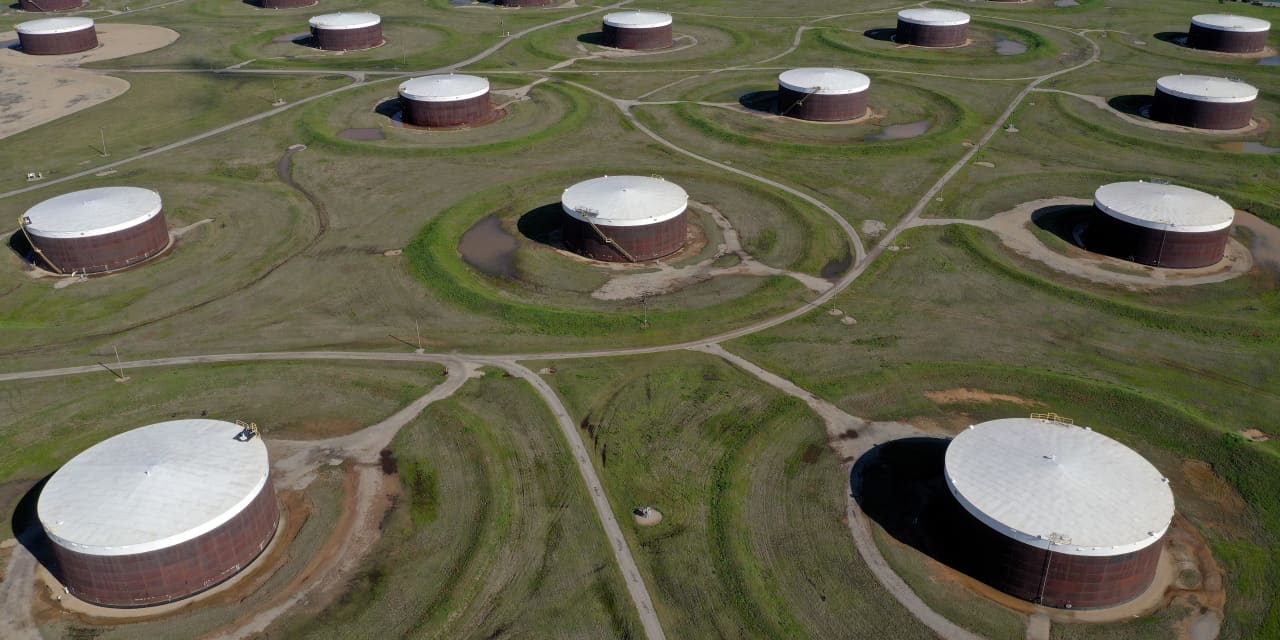A key U.S. oil town is running out of oil, and the impact is sending shivers through energy markets. It’s one reason why U.S. oil prices were trading above $94 per barrel on Wednesday for the first time since August 2022 and could eclipse $100 soon.
The explanation involves geography, chemistry, and the mechanics of oil trading. Just 8,000 people live in Cushing, Oklahoma, but the massive oil pipelines that run through the town have made it a central trading hub—and the location where West Texas Intermediate crude is priced. The WTI futures contract is the benchmark U.S. price. Every month, people who hold expiring futures contracts receive oil from the storage tanks in Cushing. That contract is one of the most important in the energy market, backing major financial products like the United States Oil ETF (ticker: USO).
Over the past month, the tanks have started to run dry. The latest government statistics released on Wednesday show that Cushing holds just under 22 million barrels of oil. Other than brief periods in July 2022 and August 2018, storage levels haven’t been this low since 2014.
“We are at really beaten-down levels” of storage, said Robert Yawger, director of energy futures at Mizuho Securities. “It’s been a slow-motion train wreck for weeks. Today it got supersized.”
The main reason for the lack of oil is that refiners are using nearly all their capacity to take crude and pump out gasoline and diesel, which are both fetching strong margins. In addition, a pipeline outage in Cushing forced oil to flow elsewhere. Gasoline prices are now at $3.83 per gallon.
Cushing has capacity for about 100 million barrels of oil, and as recently as June there were about 40 million barrels there. In April 2020, with much of the world in lockdown due to Covid-19, so much oil built up in storage that tanks were essentially full. When the WTI contract expired that month, there was nowhere to store the oil that traders had bought, and oil suddenly went negative for the first time ever.
The current situation with WTI is essentially the opposite of what happened in 2020. Instead of too much oil, there’s too little in the tanks, which causes its own problems. As oil levels fall, pressure in the tanks diminishes, and it becomes harder to move oil around, Yawger said. In some tanks, oil could drop below the level of the nozzles that allow the oil to flow out of the tanks and into pipelines.
The situation is also wreaking havoc in the oil futures market. Speculators are betting on oil prices to keep rising as oil supplies run short. The surge in prices of the November futures contract has forced the market into a particularly steep form of “backwardation”—when near-term prices are higher than future prices. Traders now have strong incentives to sell oil soon instead of holding on to it to sell later. The December contract is thus trading at a $2 discount to the November one, much wider than usual.
For traders, these kinds of spreads are enticing, but they can be dangerous. People holding on to November contracts when they expire on Oct. 20 will have to roll over the contract to the December contract if they don’t want to take possession of the oil. If December contracts still trade at big discounts, they could lose a lot of money (each WTI contract is for 1,000 barrels of oil, so a $2 difference could result in a $2,000 paper loss per contract).
Yawger doesn’t expect this month’s expiration to generate the same excitement as the 2020 oil plunge, but he does think trading could get rocky.
“It’s going to be an interesting expiration,” he said. “We don’t have any precedent. It’s not certain what’s going to happen.”
Read the full article here











